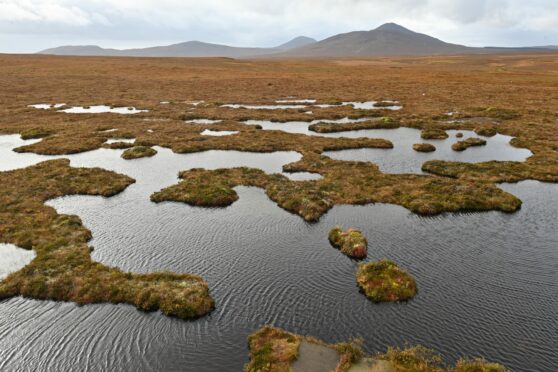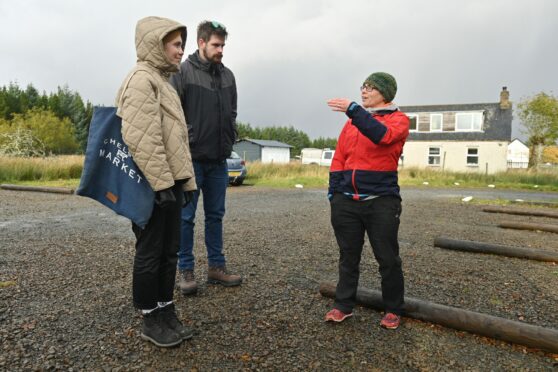The answer to climate change could be beneath out feet: peat
It is isolated, boggy and raining horizontally. Scotland’s largest peatland may not be as glamorous as tropical rainforests and arctic icebergs, but it is just as important when it comes to battling the climate crisis.
This is because thousands of tons of carbon are stored here under our feet. And unless we act now, that is under threat.
Why is Forsinard Flows under threat?
Forsinard Flows National Nature Reserve is the largest blanket bog of its kind in Europe.
Located just south of Thurso, it covers more than 200 square kilometres of remote low-lying marshland.
It doesn’t look like much. But this boggy ground is critical for preserving biodiversity, minimising flooding risk and – now this is the big one – helping to address climate change.
“Peatlands are an ecosystem that take carbon from the atmosphere and build it into organic matter that doesn’t decompose over time,” explains peatland restoration expert Roxane Andersen.
“They are very, very important for carbon sequestration,” she said.
The carbon dioxide is removed from the atmosphere and stored underground. “It is underneath our feet, in the peat.”
The problem with peatlands is that when you disturb the normal processes that allow this carbon to accumulate – it needs cold and wet conditions – they release millions of tonnes of stored carbon.
“And unfortunately in Europe, most of our peatlands are degraded like this.”
When the peatlands are degraded, they turn from a carbon sink to a net carbon source. That undermines work other work to cut emissions in Scotland.
How do you restore a peatland?
The simplest way to keep these greenhouse gases in the ground is to restore the peatland to its natural state.
That is, however, easier said than done.
Over the years there have been many ill-fated attempts to develop Forsinard Flows which mostly involved attempts to drain the bog, plant trees and dig up peat for use in the whisky industry.
Venture after venture failed to thrive and severely damaged the delicate eco-system of the landscape.
Though more and more people now value this seemingly barren land.
Specialised peatlands scientists are now working hard to put the peatlands into a fresh light.
They include Roxane and her University of the Highlands and Islands colleagues Chris Marshall and Sam Webber.
Each of them say that education is the most effective way to restore a peatland like this.
“The peatlands are an ecosystem that take a little bit of time to get to know and get to love,” Roxane said.
“So I think it’s really important that we educate people, get them to understand what peatlands are and why they’re so important.”
The @RSPBScotland viewing tower at the Forsinard Flows NNR is amazing. It's super accessible with a wooden walkway, ace for getting those with mobility issues into the ❤ of a special, beautiful, wild environment they may otherwise not be able to see first-hand. #ClimateRoadTrip pic.twitter.com/sBBUU8jtyj
— Kieran Beattie (@KNBeattie) October 21, 2021
It’s also about consistency. Roxane, Chris and Sam are attempting to push the message that if we want peatlands in future, there is no quick-fix solution.
“We need to make sure people get the message. Hear the message repeated over and over.
“That peatlands are important because they store carbon, because they support biodiversity, because they help deliver and regulate fresh water,” said Roxane.
The decades of damage and neglect must end now.
Bringing Scotland’s peatland restoration experts to COP26
Though the RSPB Forsinard Flows reserve in Caithness and Sutherland may be the largest, it is far from Scotland’s only boggy carbon store.
In fact, peatlands cover about 20% of our land, meaning that protecting these marshes is no small task.
The Scottish government’s climate change plan aims to restore 250,000 hectares (617,800 acres) of peatland by 2030.
This makes us a world leader in implementing large-scale peatland restoration. The budget allocated to the cause – a cool £250 million – reflects how seriously the government is taking the project.
Roxane is hopeful that putting Scotland on the world stage at COP26 might have an impact too.
“I really hope that something can happen at COP,” she said.
Glasgow will host a “peatland pavilion” as part of the conference. It will showcase her work and that of other similar scientists.
“I hope we can get a bit of momentum for the designation of the Flow Country as a world heritage site too,” Roxane said.
If granted, it would be the first peatland in the world to receive a UNESCO accreditation.
But Roxane is realistic. There is a lot to discuss at this global climate conference and peatlands may not be top of the agenda.
“What I would like to get out of COP is the message that we’re not going to save our planet just by restoring our peatland alone,” she said.
“But if we don’t restore our peatland, we’re at the risk of missing that 1.5 degree target.”
And that, she says, would be catastrophic in the global fight against climate change.

